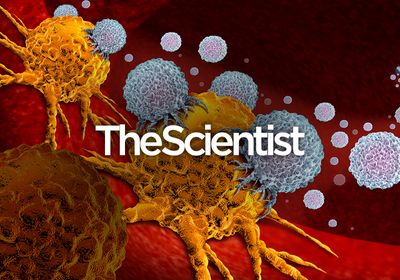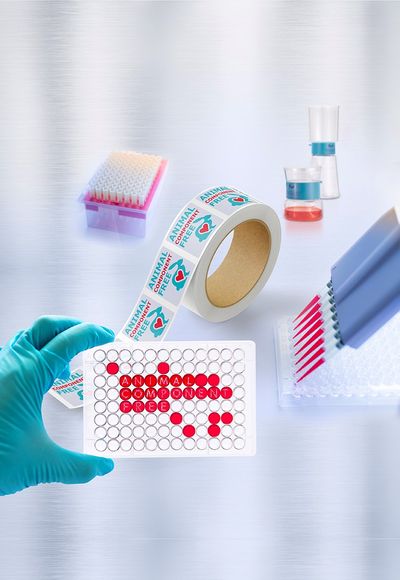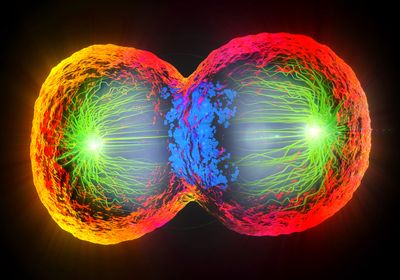ABOVE: © ISTOCK.COM, EJGRUBBS
Glioblastomas are one of the most malignant and lethal cancers. Despite recent treatment advancements, median survival is only 12 to 16 months. In 2015, the Optune device, a novel, non-invasive treatment modality was approved by the FDA for use alongside standard treatment regimens for newly diagnosed glioblastomas after a large-scale clinical trial found that it extended overall survival by at least 5 months (1,2). The Optune device is a wearable, portable instrument that uses external electrodes attached to the scalp to continuously deliver electric fields to the tumor site. But what exactly is going on under the cap?
Electric fields slow proliferation

In 2000, Yoram Palti, then an emeritus professor at the Technion-Israel Institute of Technology, founded the global oncology company Novocure with the goal of establishing the scientific groundwork and developing the technology for a new treatment modality in the fight against difficult-to-treat cancers like glioblastoma. Palti knew that cancer cells constantly undergo cell division and many key molecules orchestrating mitosis are polarizable, meaning that they have positive and negative ends that respond to an external electric field. “Palti envisioned that alternating electric fields at certain frequencies could have an impact on the intracellular components in a dividing cell in a way that will interfere with division events,” said Uri Weinberg, chief science officer at Novocure.
To test this hypothesis, Palti and his colleagues exposed cancer cells in a dish to alternating current electric fields administered at a variety of intensities and frequencies (3). They found that constant delivery of these alternating electric fields at a low intensity and an intermediate frequency of 100-300 kilohertz — or 100,000 to 300,000 changes in the current direction every second — prolonged mitosis in cancer cells and even induced cell death in some of the treated cells. To examine the in vivo potential of these electric fields, referred to as tumor treating fields (TTFields), the scientists injected cancer cells under the skin of mice in two parallel locations on the back. They placed insulated wires above both tumor sites but only delivered TTFields to one side. After nearly a week of constant treatment, Palti and his colleagues found a reduction in tumor growth only on the side receiving TTFields. In a subsequent study, the scientists further demonstrated the efficacy of TTFields in reducing brain tumor growth in rats using external electrodes affixed to the head (4).

These pivotal studies later demonstrated how TTFields capitalize on two fundamental physical processes to interfere with mitosis. During mitosis, tubulin proteins link together to form long microtubules. The microtubules reach from the edges of the cell towards the center to grab and pull sister chromatids to opposite sides of the cell. Application of TTFields creates rotational forces on polarized tubulin proteins as the positive and negative sides move back and forth with the changing currents. Under these forces, tubulin proteins struggle to build microtubules, leading to prolonged mitosis. Impairments in the structural integrity of microtubules can lead to abnormal separation of the sister chromatids, triggering cell death events.
TTFields’ anti-mitotic effects don’t stop there. Cells that manage to successfully pull the sister chromatids apart assume an hour-glass shape as they prepare to split in two. However, TTFields generate a non-uniform electric field around the cell, meaning that electric fields angle towards the furrow of the cell, creating an area of high-intensity. This causes dielectrophoresis, a phenomenon where polarizable molecules like microtubules are inappropriately drawn towards the center of the dividing cell. This process can further prolong cell division or introduce structural impairments that trigger cell death.
An added benefit of TTFields is that their forces are localized to the tumor area and specifically target cancer cells while sparing normal cells (3). Normal cells undergo significantly fewer division events, and their membrane capacitance properties are different enough from cancer cells to evade the constant bombardment of alternating currents.
At the tip of the TTFields iceberg
“Perhaps one thing that we don't know yet is the full appreciation and understanding of all the mechanisms of action of tumors during field therapy,” said Minesh Mehta, a radiation oncologist at Miami Cancer Institute. Since their debut in 2004, TTFields have received increasing attention for their therapeutic benefits. However, there is growing evidence that the therapeutic effects of TTFields may go beyond their anti-mitotic effects (5).
For example, recent studies showed that TTFields induce inflammation and activate adaptive immunity (6), suggesting that TTFields may augment the immune response and increase cancer cells’ sensitivity to drugs like immune checkpoint inhibitors. Other research groups reported that TTFields impair DNA repair mechanisms (7), opening the possibility of using them synergistically with other treatments that cause DNA damage such as radiation therapy or PARP inhibitors.
“We are only seeing the tip of the iceberg when it comes to the potential efficacy of TTFields,” said Weinberg.
References
- Stupp, R. et al. Maintenance therapy with tumor-treating fields plus temozolomide vs. temozolomide alone for glioblastoma: A randomized clinial trial. JAMA 314, 2535-2543 (2015).
- Stupp, R. et al. Effect of tumor-treating fields plus maintenance temozolamide vs. maintenance temozolamide on survival in patients with glioblastoma: A randomized clinical trial. JAMA 318, 2306-2316 (2017).
- Kirson, E.D. et al. Disruption of cancer cell replication by alternating electric fields. Cancer Research 64, 3288-3295 (2004).
- Kirson, E.D. et al. Alternating electric fields arrest cell proliferation in animal tumor models. PNAS 104, 10152-10157 (2007).
- Rominiyi, O. et al. Tumor treating fields therapy for glioblastoma: Current advances and future directions. Br J Cancer 124, 697-709 (2020).
- Chen, D. et al. Tumor treating fields dually activate STING and AIM2 inflammasomes to induce adjuvant immunity in glioblastomas. (2022)
- Karanam, N.K. et al. Tumor treating fields cause replication stress and interfere with DNA replication for maintenance: Implications for cancer therapy. Translational Research 217, 33-46 (2020).
This story was originally published on Drug Discovery News, the leading news magazine for scientists in pharma and biotech.








